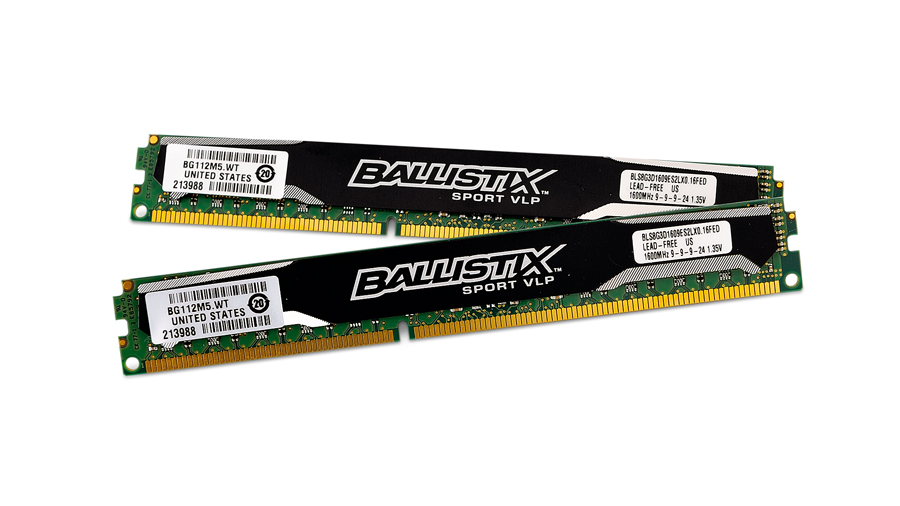TechRadar Verdict
Pros
- +
Low latency and voltage
- +
Can be overclocked to stable 2,133 Mhz
- +
No more clashes with the heatsink
Cons
- -
Tactical LP have slight performance advantage
Why you can trust TechRadar
What's the VLP moniker stand for? Why Very Low Profile, of course. The Sport VLP modules measure just 18mm from the base of the electrical contacts to the top of the heatsink, or to put it another way, once the sticks are installed they just come up to the top of the memory latch.
Not the raised bit you use to lower the latch with either, but the latch body itself - whichever way you decide to look at it that's remarkably short.
As with the company's Ballistix Tactical LP range the Sport VLP line-up currently only consists of DDR3 PC3-12800, 1,600MHz modules running at 1.35V. Crucial currently offers these modules in single 4GB and 8GB density modules or as 8GB, 16GB or 32GB memory kits.
The kit we reviewed here is the 16GB set, which comprises a pair of 8GB unbuffered NON-ECC modules in tandem.
On boot up, the Asus motherboard, we use for the testing, reported the modules as running at 1,333MHz with 9-9-9-24 timings at 1.35V if the memory settings in the BIOS were set to Auto. Changing to the XMP settings the memory was reported at correctly at 1,600MHz with 9-9-9-24 timings - another clear reminder that you should always check memory timings in the BIOS and adjust accordingly.
The XMP shizzle thankfully takes all the hassle out of configuring the latency timings yourself.
Clock-happy
Just like the Tactical LP modules these wee Sport VLP modules are fairly sprightly at their stock settings, but also remarkably compliant when it comes to overclocking. Keeping the default timings and voltage and just changing the speed in the motherboard BIOS options to 1,866MHz resulted in a non-booting board, but a slacking off of the latency settings to 11-11-11-28 1T (still at the stock 1.35v) got the memory running rock solid at 1,866MHz.
Keeping the same CAS11 settings but altering the speed to 2,133MHz caused the motherboard, again, not to boot, but increasing the voltage to 1.6V got us to a rock solid (even when being pushed hard in the benchmark tests) 2,133MHz.
No matter what we tried to get a bit more out of our review modules, 2,133MHz remained the fastest stable speed we could achieve, but as with all things memory related, you might get lucky and find modules that turn out to be a bit more obliging.
Benchmarks
Memory bandwidth performance
Sisoft Sandra: Gigabytes per second: Higher is better
SPORT VLP @ 1,600MHZ (1.35V): 21
TACTICAL LP @ 1,600MHZ (1.35V): 21
SPORT VLP @ 2,133MHZ (1.60V): 26
TACTICAL LP @ 2,133MHZ (1.5V): 28
Video encoding performance
x264: Frames per second: Higher is better
SPORT VLP @ 1,600MHZ (1.35V): 40.44
TACTICAL LP @ 1,600MHZ (1.35V): 40.34
SPORT VLP @ 2,133MHZ (1.60V): 40.50
TACTICAL LP @ 2,133MHZ (1.5V): 40.52
Gaming performance
Batman: AC: Frames per second: Higher is better
SPORT VLP @ 1,600MHZ (1.35V): 123
TACTICAL LP @ 1,600MHZ (1.35V): 123
SPORT VLP @ 2,133MHZ (1.60V): 125
TACTICAL LP @ 2,133MHZ (1.5V): 126
The fact these modules work so well with tiny heatsinks - even when being overclocked - confirms our general feelings that all those lower speed modules with their large flashy heatsinks, are more to do with catching the attention of your wallet rather than any real cooling function.
Still, the overclocking prowess of these sticks is not really the point. The low latency settings, decent performance and incredible size make this a rather desirable little set. Low-profile, low latency and low voltage - that's quite a combo, and the added versatility offered via the overclocking makes the Sport VLP a great prospect.
